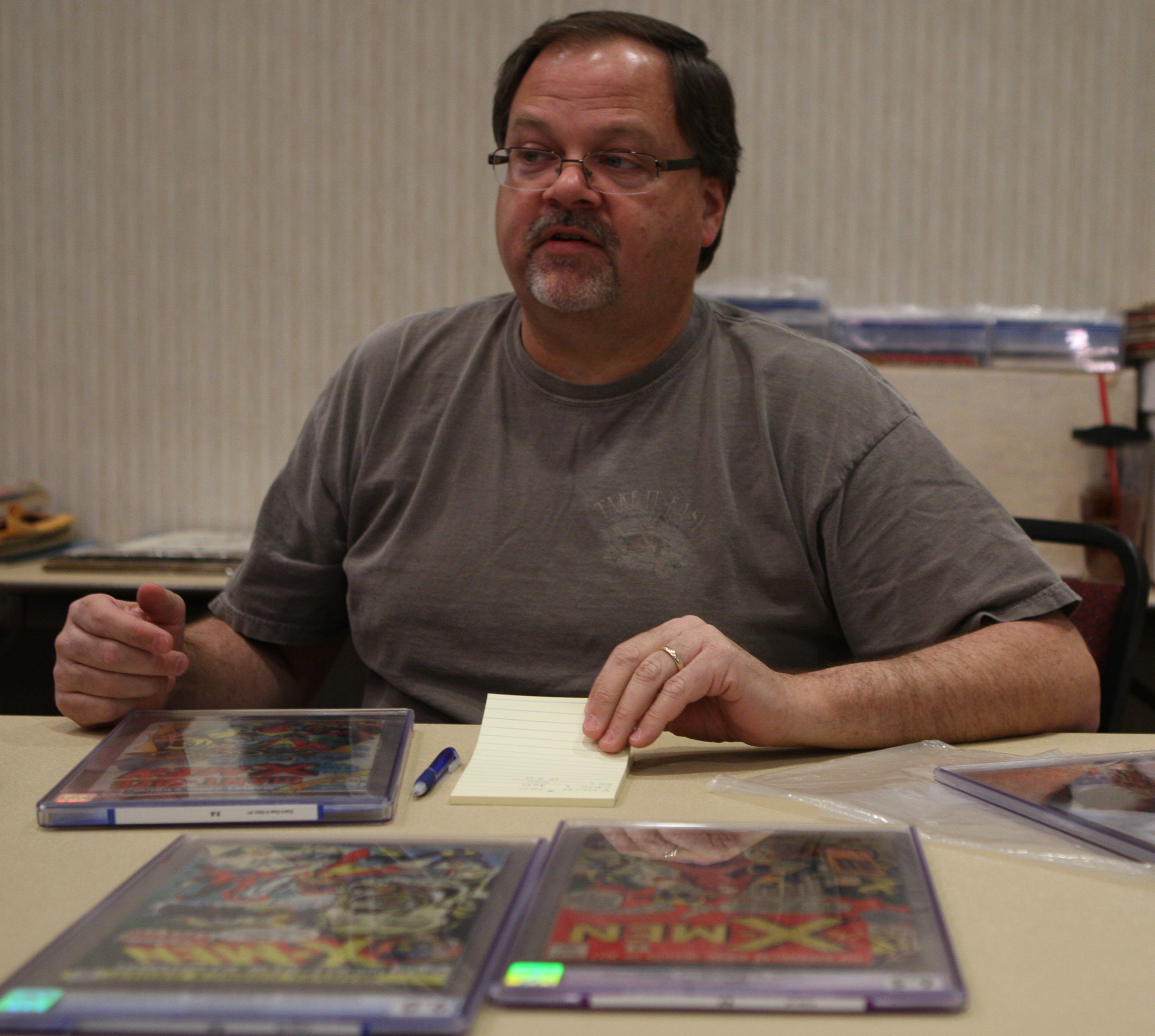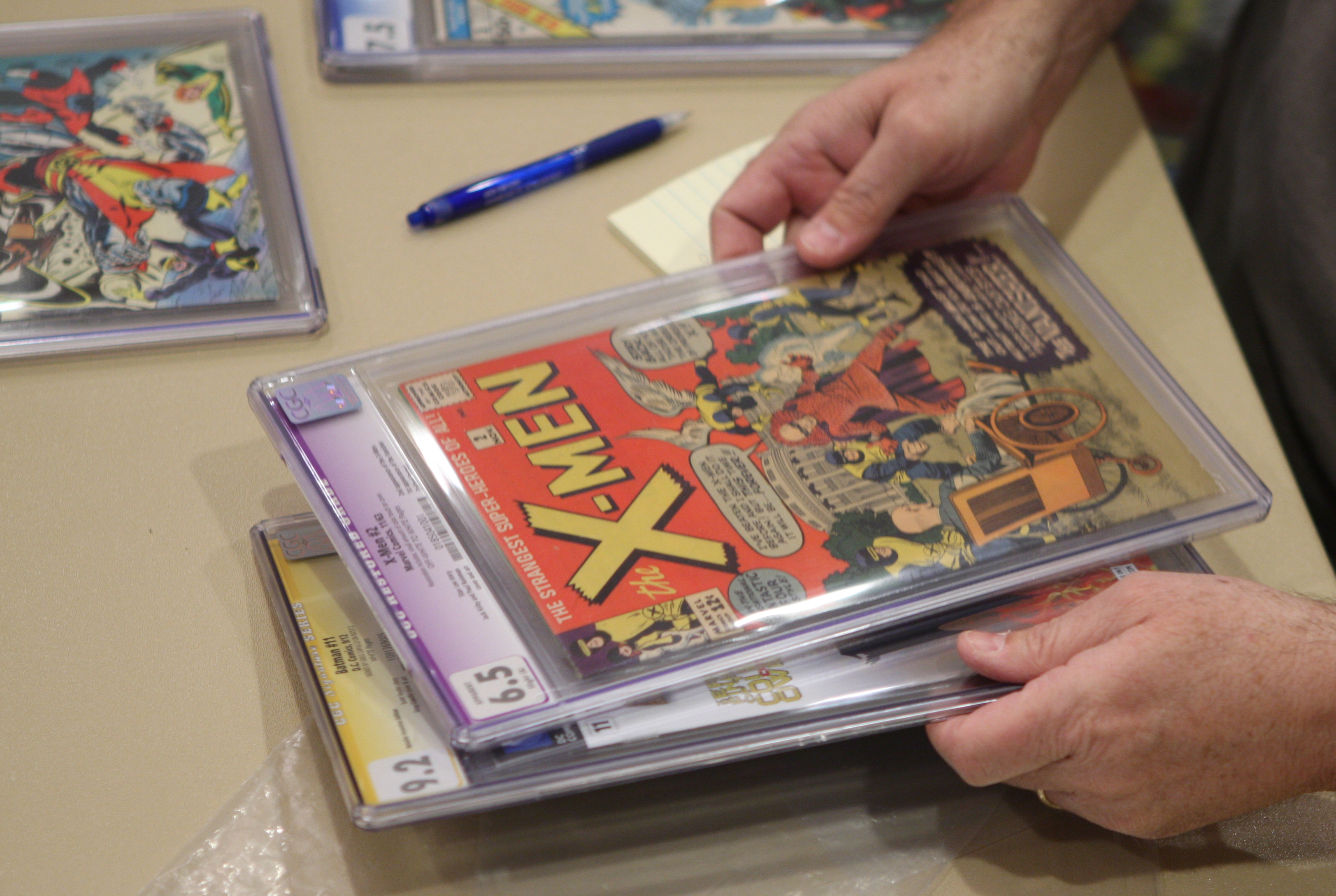Comic craving: Collectors, dealers on constant quest to find hidden gems
Tuesday, February 4, 2014
GRADING SCALEThe following is a sample of the scores assigned by the Certified Guaranty Co. when rating the condition of comics. Each issue is examined for imperfections such as tears, creases or split spines before receiving a final grade. Higher grades are more valuable. For information on how to submit comics for CGC evaluation, visit www.cgccomics.com/services/index.asp.• 0.5: Poor• 1.5: Fair/good• 3.0: Good/very good• 5.0: Very good/fine• 7.0: Fine/very fine• 9.0: Very fine/near mint• 9.8: Near mint/mint• 9.9: Mint• 10: Gem mint
BUYING & SELLINGComic book dealer Leroy Harper says he may return to Chattanooga in coming weeks to follow up with sellers who missed his January trip. To request an appraisal, email lhcomics@hotmail.com or call 270-748-9364.
GREAT POWER, GREAT WORTHThe following are the estimated value for near-mint condition copies of the most desirable comics in the world:• 1."Action Comics No. 1," 1938: $2.8 million; first appearance of Superman• 2."Detective Comics No. 27," 1939: $2.25 million; first appearance of Batman• 3."Superman No. 1," 1939: $766,000; first standalone Superman issue• 4."Batman No. 1," 1940: $571,000; first standalone Batman issue• 5."Detective Comics No. 1," 1937: $566,000; first issue in longest-running comic book in the U.S.Source: Nostomania.comBEST SELLERSThe following have been the top-selling issues since 2000:• 1."Amazing Spider-Man No. 583," 2009: 530,500 copies• 2."Walking Dead No. 100," 2012: 384,800 copies• 3."Civil War No. 2," 2006: 341,900 copies• 4."Civil War No. 3," 2006: 337,000 copies• 5."Walking Dead No. 115," 2013: 329,300 copies• 6. "Civil War No. 1," 2006: 328,500 copies• 7."Justice League of America No. 1," 2013: 326,000 copies• 8."Captain America No. 25," 2007: 317,700 copies• 9."Uncanny Avengers No. 1," 2012: 305,900 copies• 10. "Civil War No. 4," 2006: 291,000 copiesSource: Comichron.com
A 30-year veteran of comic collecting and selling, Harper, 52, stores an inventory of 16,000 to 20,000 at his home in Paducah, Ky. The showpiece items, such as No. 1 issues of "Batman" and "Captain America," are kept in his office. Run-of-the-mill, low-value books end up in the garage.
The most tired and tattered material, however, goes out with the trash.
During a late January trip to Chattanooga to find new inventory, Harper estimates he and his partner, Pete Przysiezny, spent about $20,000 buying 12,000 to 14,000 issues from local collectors, a load so big it filled a Dodge Caravan and a mid-size SUV to the brim.
But not everything made it back.
"It was so much stuff we had to leave boxes behind. That was a first," Harper says. "I didn't think we'd go down there and not be able to haul everything back.
"It wouldn't surprise me if ... I throw from 500 to 1,000 away because they're so beat up that they have no value."
A BITTER PILL
To many lifelong collectors, the thought of comic books they squirreled away as investments winding up in a bag on the curb is almost painful. Even after accounting for inflation, a selling price of $3 or $4 for a 1980s-era "Fantastic Four" would be a pretty high return on the initial 65-cent investment, but comic hounds tend to have high expectations of their collections' value.
But some collectors say their most cherished issues would never end up on Harper's evaluation table. Occasionally, sentimental value, not market demand, can render issues essentially priceless to their owners.
"As far as my personal collection, it would be 'Power Man and Iron Fist No. 83,'" writes Keith Finch of Rossville, Ga., a member of the Facebook group Chattanooga-Area Comic Collectors. "Someone left it in my desk in math class in seventh or eighth grade and never claimed it, and that series has ended up being one of my favorites."
Atlanta's Brandon Woodson, 40, began reading comics more than 35 years ago, He was forced to start over after losing everything in a 1987 house fire and since has acquired more than 4,000. Of his current collection, Woodson says his "Spider-Man" issues are all-but-sacrosanct, but there's one he could never see parting with: "Amazing Spider-Man No. 300."
"[That issue] was a huge milestone and helped introduce Todd MacFarlane as an artist as well as the character Venom, but that's not why it's my absolute favorite," he writes. "My favorite aunt, Barbara, bought that comic for me for Christmas. Comics mean more to me when they are gifts."
BIG DREAMS
Collectors' sky-high expectations are fueled, in part, by stories -- almost myths -- of hidden treasures being uncovered in unlikely places and selling for astronomical prices.
In 2012, a man in Virginia found a treasure trove in his great aunt's basement, a collection of 345 well-preserved comics that included some of the most-sought-after by collectors, including the 1939 issue of Detective Comics No. 27 that introduced Batman. At an auction in Dallas, the bulk of the collection sold for $3.5 million.
Last year, a house renovator in Elbow Lake, Minn., found the Holy Grail of comic books, an issue of "Action Comics No. 1," which features the first appearance of Superman. The issue had been used as insulation in the home, and its torn cover severely downgraded its estimated value, but it still managed to fetch $175,000 at auction, a 17,500 percent increase over the original 10-cent asking price in 1938.
Despite looking at 75 to 100 collections every year, Harper says he's never seen an "Action Comics No. 1." Few copies of it -- or any comics from the late 1930s and early 1940s -- survived the paper recycling campaigns of World War II. Only an estimated 200 copies of Superman's debut still exist from the initial print run of 200,000, and Harper's show advertisements guarantee a minimum purchase offer of $20,000 if someone brings one in.
But those issues are the exceptions to the rule, the comic equivalent of blue-chip stalwarts that are all but guaranteed to increase in value. Successful sales of these comics helped fuel buying bonanzas in the '80s, when collectors began shelling out for multiple copies of new releases in the hopes of selling them off in the future.
The huge supply of comics from that era, even well-preserved copies, can drastically reduce their value. Not that that stops collectors from dreaming, Harper says.
"Someone will bring me a 'Spider-Man No. 62,' and on eBay, they'll say it's going for $160. I'll look it up and say, 'Which one of these 120 'Spider-Man No. 62s' do you want to look at?'" he says. "You know if there are 100 of an item on eBay, that drives the price way down.
"You need to look at what people are selling at, not what they're asking at."
INK IN THE DESERT
Harper became interested in comics in the 1970s while growing up in a Western Kentucky town so small the only source of new books was the spinning rack in the neighborhood drugstore.
Like many collectors, he saw resell prices of older comic issues on the rise, so he began buying up multiple copies of new issues hoping for their value to appreciate. In 1975, he bought his first collectible, a 1966 issue of "Silver Surfer No. 1," for $7.50 through a mail-order catalog.
By the time he graduated high school, Harper had acquired about 800 comics. At the time, it seemed a substantial collection, but now, it would barely account for a fraction of what he purchases on the half dozen selling trips he makes every year. In his line of work, the sheer amount of content can deaden the thrill he used to feel for comics.
"I've had so many 'Spider-Man No. 1's' go through my hands that they just don't interest me anymore," he laughs. "It's crazy; it should. I like it, but as soon as I get one, I'm going to sell it."
Although he barely has a chance to read new comics anymore and only has 100 comics in his personal library, Harper says he's not immune to the collector's itch. He says he'd do just about anything to own a high-grade copy of Batman's third appearance in "Detective Comics No. 31," which features one of the comic world's most-iconic covers.
Harper says he depends on collectors to bring him new items, a practice that sometimes feels like waiting for sunken treasure to wash up with the tide but, in the coming months, finding new inventory will become even more important.
For years, Harper's day job was working as an instrument planner at a uranium enrichment plant in Paducah, Ky., run by United States Enrichment Corp., a contractor for the U.S. Department of Energy. USEC announced last year that the plant would be shut down and, with his current job in jeopardy, Harper says he plans to turn comic dealing into a career.
That means making more purchasing trips and, despite the overwhelming supply he brought back from Chattanooga, Harper says he probably will return in the coming weeks to meet with sellers who weren't aware he was here the first time.
Even though he's facing employment upheaval, Harper says he's not concerned about his financial prospects. There are thousands of comics he says are barely worth the time it takes to haul them to the curb, but there also are many that will only gain in value and continue to fascinate collectors.
And that, he says, is like hand-inked job security.
"Even after the market crash in 2008, comics never skipped a beat," Harper says. "I never had a moment of 'What are we going to do with all these comics no one is buying?'
"Quality books will always be in demand. They have been recession-proof."
Contact Casey Phillips at cphillips@timesfreepress.com or 423-757-6205. Follow him on Twitter at @PhillipsCTFP.



